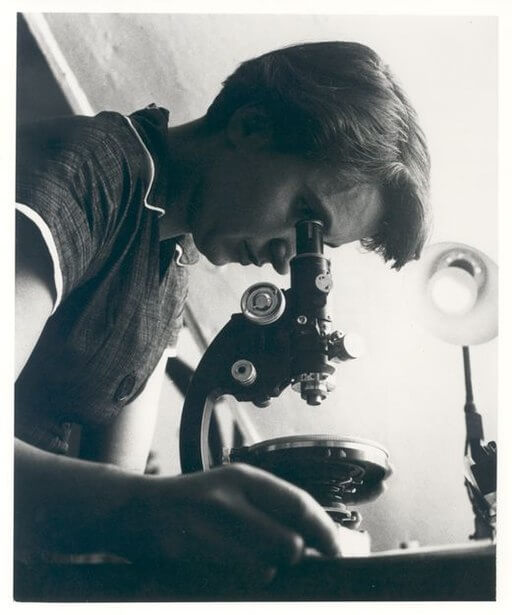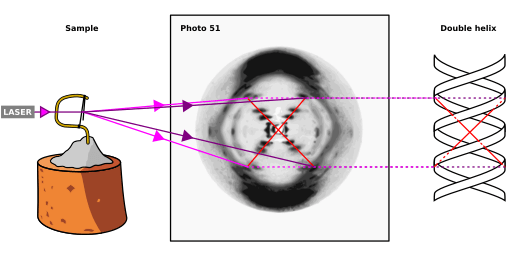The discovery of the DNA structure is one of the greatest scientific achievements of the 20th century. It revolutionized molecular biology by allowing us to understand how genetic characteristics are passed from one generation to another. However, this story also has a lesser-known side: the essential contribution of Rosalind Franklin, a scientist whose work was crucial but long underestimated. In this article, we will explore who Rosalind Franklin was, how her work shaped our understanding of DNA structure, and why her recognition came so late.

Who Was Rosalind Franklin?
Rosalind Franklin was a British scientist, born in 1920, who from an early age showed great interest in science. She studied chemistry at Cambridge and began her career working with coal and graphite, but it was during her work with X-ray crystallography that her most important contribution emerged. X-ray crystallography was an essential technique for unveiling molecular structures, and Franklin mastered it like few others.
From Coal to DNA: The Scientific Journey
Before working with DNA, Franklin had already made a name for herself with research on the physical properties of coal and other carbon materials. She used X-ray crystallography techniques to understand how these materials were structured. This expertise would later prove essential when she began applying the same techniques to study DNA.
When she was invited to work at King’s College London in 1951, Franklin began to use her skill in X-ray crystallography to study DNA. It was there that she produced the famous X-ray diffraction images, including the renowned “Photo 51,” which would be key evidence in discovering the structure of the DNA double helix.
The Research Landscape in the 1950s
In the 1950s, the race to uncover the structure of DNA was in full swing. Many scientists believed that understanding how DNA was formed could be the key to unlocking the secrets of genetics. Among the key figures in this scientific race were James Watson, Francis Crick, and Maurice Wilkins—scientists who would later become famous for their contribution to the discovery.
The Importance of DNA in Molecular Biology
DNA is the molecule responsible for storing all the genetic information of living organisms. Molecular biology studies exactly how this information is transmitted and how the structure of DNA facilitates these processes. In the early 1950s, although the importance of DNA was already known, there were still many doubts about its exact structure. It was necessary to understand its structure in order to comprehend how it worked. This was the major question to be answered at the time.
The King’s College Team
Rosalind Franklin arrived at King’s College to work with Wilkins, but right from the start, there was a communication breakdown. Wilkins thought Franklin would be his assistant, while she had been hired to work as an independent researcher. This misunderstanding marked the beginning of a complicated professional relationship, one that would have major implications for the future.
Franklin’s Contribution: Photo 51 and the Structure of DNA
What few people know is that one of the most decisive moments in the discovery of DNA’s structure came from the work of Rosalind Franklin. Using X-ray crystallography, Franklin was able to capture detailed images of the DNA molecule. One of these images, known as Photo 51, clearly showed a diffraction pattern that suggested a helical structure.

What Was Photo 51?
Photo 51 was the result of months of Franklin’s work with DNA samples. She had adjusted the conditions so precisely that she managed to capture the clearest image of the molecule taken up to that point. The photo showed a characteristic “X” pattern, indicating a helical structure—in other words, a spiral shape—which became one of the main clues to understanding how DNA is organized.
If you’ve ever played with a spring model or made a paper spiral, you can imagine what this helical structure looks like. In the case of DNA, the two strands that form the double helix are connected by pairs of nitrogenous bases, like a twisted ladder—something that would become a hallmark of molecular biology.
The Impact of Photo 51
Although Franklin was meticulous and confident in her results, she had not yet completed the full interpretation of the data when Photo 51 was seen by James Watson and Francis Crick—without her knowledge. Maurice Wilkins, a colleague of Franklin, showed the photo to Watson, who immediately recognized its significance. Watson and Crick, who were already trying to decipher DNA in Cambridge, used this crucial information to propose the double helix model.
Franklin’s contribution is clear: without her data and the clarity of Photo 51, Watson and Crick would have struggled to reach the correct DNA structure. However, in their historic 1953 paper in Nature, which described the double helix model, Franklin was only briefly mentioned as a data source.
“Science and everyday life cannot and should not be separated.”
– Rosalind Franklin
The Nobel Prize and Belated Recognition
In 1962, Watson, Crick, and Wilkins received the Nobel Prize in Physiology or Medicine for the discovery of the DNA structure. Rosalind Franklin, who had died of cancer in 1958, was not mentioned in the award. It is worth noting that the Nobel Prize cannot be awarded posthumously, but many critics argue that she should have been recognized during her lifetime.
Why Was Rosalind Franklin Not Recognized?
There are several reasons why Rosalind Franklin did not receive the recognition she deserved. The first is the social context of the time. In the 1950s, science was dominated by men, and many women faced prejudice and obstacles in having their contributions acknowledged.
Another factor is that Watson and Crick were quick to publish their results, while Franklin was still carefully analyzing her data. They used Franklin’s information without her knowledge, which generated much controversy. In their books and interviews, Watson, for example, downplayed the importance of Franklin’s contribution, which helped reinforce the invisibility of her work for decades.
The Legacy of Rosalind Franklin
Today, Rosalind Franklin is widely recognized as one of the central figures in the discovery of the structure of DNA. Her work with X-ray crystallography not only revolutionized the field of molecular biology but also paved the way for many subsequent scientific advances. Since then, laboratories, awards, and research centers have been named in her honor, and her legacy continues to inspire scientists around the world.
Contributions to Virology
In addition to her groundbreaking work with DNA, Rosalind Franklin also made important contributions to virology, another crucial area of molecular biology. After leaving King’s College, she began working on the tobacco mosaic virus at Birkbeck College in London. Using her skills in X-ray crystallography, Franklin helped determine the molecular structure of various viruses, including the poliovirus. Her research was fundamental to understanding the composition and replication of viruses, opening new doors for the development of vaccines and antiviral treatments. This work in virology highlighted her scientific versatility and ability to apply her innovative techniques across different areas of science, significantly contributing to advances in virology and their impact on human health.
The Impact of Her Discoveries on Modern Molecular Biology
The understanding of DNA’s structure was not just a scientific victory—it transformed our view of life itself. Thanks to this discovery, technologies such as cloning, genome sequencing, and gene therapy became possible. All these advances are, in part, the result of Franklin’s pioneering work.
In addition, her research directly influenced the development of fields such as medicine, biotechnology, and agriculture, demonstrating how molecular biology is fundamental to many modern industries.
Learn more about Rosalind Franklin

Women in Science – Rosalind Franklin (MSMIN3)
Rosalind Franklin as a Role Model for Future Scientists
The belated recognition of Rosalind Franklin leads us to reflect on the importance of ensuring that all scientists—regardless of gender or social background—receive the credit they deserve for their contributions. Franklin became a symbol of women’s struggle in science, and her story continues to inspire new generations of scientists.
Rosalind Franklin played a fundamental role in the discovery of DNA’s structure, and her contribution to molecular biology is undeniable. Although she was underestimated during her lifetime, her legacy continues to be celebrated. Franklin’s story reminds us of the importance of giving credit where it is due and of continuing to recognize the contributions of those who help expand our understanding of the world.
References
- The role and contributions of Rosalind Franklin in the elucidation of the DNA structure: a historical overview based on bibliographic research.
https://periodicos.ufsc.br/index.php/alexandria/article/view/91492 - FERREIRA, R. The history of the discovery of the DNA structure. São Paulo: Odysseus, 2003.
- Photo 51: The fascinating story behind the famous image of Rosalind Franklin and the structure of DNA.
https://www.bbc.com/portuguese/geral-61393662